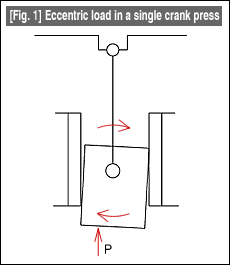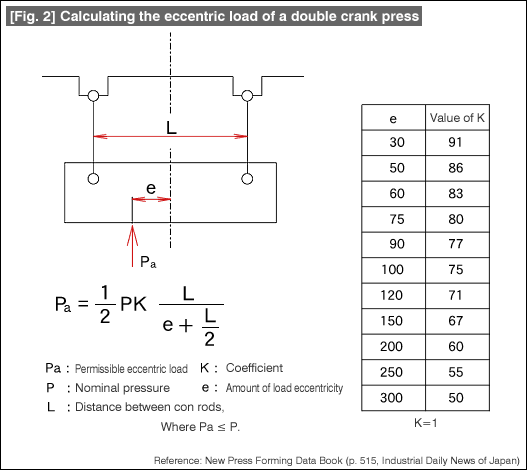#046 Relationship Between Press Machine and Die (4) Eccentric Load on Press Machine
(the center of the forming force when the die is working) matches with the center of the slide of the press machine. However, due to the restrictions of the product shape or due to the forming method, etc., in a large number of cases it may be difficult to make the center of the die match with the center of the load. In the dies for progressive formation, it can be assumed that all the centers of dies are shifted from the center of the load. When such a die is installed in a press machine, an eccentric load will be applied because the center of the press machine and the load center are shifted with respect to each other.
| In a single crank press machine (one point press), the slide becomes tilted as is shown in Fig. 1, and the parallelism between the bolster plate and the slide gets disturbed. This inclination is proportional to the magnitude of the load. Naturally, even the life of the die is affected. In a single crank press machine, there are no rules about the relationship between the eccentricity and the load. It is necessary to take measures such as making the eccentricity small by changing the method of installing the die, or to use a press machine with a large capacity. |  |
In the case of a double crank press machine (two points), the effect will be smaller compared to a single crank press machine. In the case of formation of products demanding accuracy, one of the reasons why the use of a double crank press machine is better than the use of a single crank press machine is the relationship with this eccentric load. The method of obtaining the permissible eccentric load of a double crank press machine is shown in Fig. 2.

- #167 Problems in Punching and their Countermeasures (6) Scrap Processing in Punching
- #166 Problems in Punching and their Countermeasures (5) Trimming of Drawn and Shaped Parts
- #165 Problems in Punching and their Countermeasures (4) Scrap Clogging in Punching
- #164 Problems in Punching and their Countermeasures (3) Bending and Twisting of Narrow Punched Parts
- #163 Problems in Punching and their Countermeasures (2) Bending due to Punching



